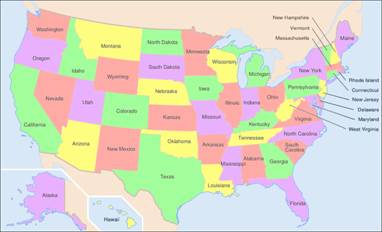|
Government : Constitutional Principles : Section One
Structure of the Constitution
* - While reading this section, refer to the text of the Constitution.
The United States Constitution has many sections, but overall it is a rather short document. The entire document, in its original form, contains less than 5,000 words. It begins with an introduction called the Preamble and then contains 7 articles and a series of amendments that will be covered in detail in a later section of this unit.
Let’s begin by examining the Preamble:
 |
We the People of the United States, in order to form a more perfect Union, establish Justice, insure domestic Tranquility, provide for the common defence, promote the general Welfare, and secure the Blessings of Liberty, to ourselves and our Posterity, do ordain and establish this Constitution for the United States of America. |
This single sentence introduces the document and its purpose. It states what the Constitution will do, but does not actually grant any specific powers or make any direct rules. The principle of democracy is very clear with the introductory phrase “We the People.” It shows that the framers understood and valued the role of the people in making and running the government. The Preamble says that the Constitution creates a government that will provide stability and order, protect the rights and liberties of citizens, and serve the people’s needs.
Following the Preamble are seven articles. Each one with its own purpose:
Article I:
 This article establishes the powers of the legislative branch. The main task of the legislative branch is that of making laws. It creates a bicameral legislature consisting of the House of Representatives and the Senate. It outlines therequirements for becoming a member of Congress. To be elected to the House, one must be at least 25 years old, have been a US citizen for 7 years, and must live in the district from which he/she is elected. To be a Senator, one must be at least 30 years old, have been a US citizen for 9 years, and must live in the state from which he/she is elected. This article establishes the powers of the legislative branch. The main task of the legislative branch is that of making laws. It creates a bicameral legislature consisting of the House of Representatives and the Senate. It outlines therequirements for becoming a member of Congress. To be elected to the House, one must be at least 25 years old, have been a US citizen for 7 years, and must live in the district from which he/she is elected. To be a Senator, one must be at least 30 years old, have been a US citizen for 9 years, and must live in the state from which he/she is elected.
Article I also explains the procedure for electing members of Congress and many other specific procedures and rules for the legislative branch. Section 8, known as the expressed powers, clearly outlines the powers that are given to Congress by the Constitution. Section 9 outlines things that Congress cannot do. Section 10 provides a list of things the states cannot do.
We will cover the legislative branch in detail in Unit 4.
Article II:
 Article II establishes the Executive Branch. This branch is charged with executing the law, or making sure that laws are followed. The article explains that only natural born American citizens, having lived in the United States for at least 14 years, and having reached the age of 35 may be eligible for the office of president. Article II establishes the Executive Branch. This branch is charged with executing the law, or making sure that laws are followed. The article explains that only natural born American citizens, having lived in the United States for at least 14 years, and having reached the age of 35 may be eligible for the office of president.
The article also explains many of the powers of the president, calls for the president to deliver the State of the Union speech to Congress, and states that officials of the government may be removed from power by impeachment in the case of “high crimes and misdemeanors.”
We will cover the executive branch in detail in Unit 5.
Article III:
 This article establishes the Judicial branch of government. It creates a system of courts including the Supreme Court and empowered Congress to create a system of lower, less powerful courts. It also discusses punishment for acts of treason against the government. This article establishes the Judicial branch of government. It creates a system of courts including the Supreme Court and empowered Congress to create a system of lower, less powerful courts. It also discusses punishment for acts of treason against the government.
We will cover the judicial branch in detail in Unit 6.

Article IV:
Article IV partly establishes the system of federalism by explaining some of the responsibilities of the national government to the states, and the relationship of the states to each other. It says that all states must recognize documents and laws of other states. A modern example of this is how a driver’s license issued in one state is still good in another. This article also explains the procedure for how a new state can be admitted into the United States.
Article V:
This article provides the details for how the Constitution can be amended. This is an important process because it allows the Constitution to change with the times and adapt to way the world changes. This ability to amend the Constitution, along with its general nature, is credited for allowing the document to survive for so long and still be so useful.
We will cover the amendment process in detail in the final section of this unit.
Article VI:
This article states that the Constitution and federal laws, or those made by the national government, are to be the supreme law of the land. This means that if there is a conflict between a state law and a federal law, the federal law is the one that must be followed.
Article VII:
Article VII outlines the process for ratification. It states that 9 out of the 13 existing states needed to ratify the document in order for it to be adopted and become the official law of the land.
Bill of Rights and the other Amendments:
 The Bill of Rights is the collective term for the first ten amendments to the Constitution. They were collectively ratified on December 15, 1791, and were designed to secure the liberties of citizens and prevent the government from taking away those liberties. A total of 27 amendments have been passed to date. The Bill of Rights is the collective term for the first ten amendments to the Constitution. They were collectively ratified on December 15, 1791, and were designed to secure the liberties of citizens and prevent the government from taking away those liberties. A total of 27 amendments have been passed to date.
We will discuss the amendments in more detail in Section 4 of this unit.
Overall, the Constitution did three things in creating our system of government:
- It created a system with three branches of government in a federal system
- It distributed specific powers to specific parts of the government
- It limits the powers of the government.
In the next section, we’ll look at the six major principles of the Constitution, and see how the government both grants and limits powers using these principles.
 Watch this video on the structure of the Constitution. Watch this video on the structure of the Constitution.
 Now, it’s time to complete an assignment. Proceed to the assignment called "Failed Amendments." Read it over and complete the questions; then submit your responses to your instructor. Now, it’s time to complete an assignment. Proceed to the assignment called "Failed Amendments." Read it over and complete the questions; then submit your responses to your instructor.
Before beginning the section 1 quiz, be sure you’ve visited the text of the Constitution and familiarized yourself with its contents.
 Now it’s time to take the quiz on section 1. When you are finished, proceed to section 2. Now it’s time to take the quiz on section 1. When you are finished, proceed to section 2.
Go to next section |